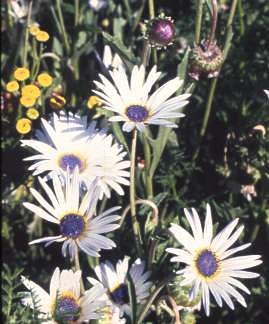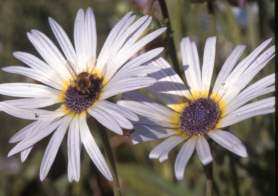Arctotis venusta
Arctotis venusta Norl.
Family: Asteraceae
Common names: Karoo marigold (Eng.); Karoo gousblom (Afr.)
Introduction

Arctotis venusta is one of the few indigenous annuals that are easy to grow and provide a reliable, colourful display in summer.
Description
Description
A fast-growing summer annual, Arctotis venusta has a number of upright, branching stems and a strong taproot. Lush plants can easily grow up to 500 mm high, forming soft, round bushes. The light green, leathery leaves are covered with short white hairs that give the plant a grey appearance. The size and the shape of the leaves differ, varying on the same plant from fat and oval to long and narrow, with leave margins that are finely toothed or deeply scalloped.

The large white flowers that form just above the foliage are very attractive. Close up, the single daisy flowerheads look quite delicate with their unusual mauve centres surrounded by a single row of shiny white petals. A bright yellow ring at the base and a light mauve wash to the back of the petals add further interest. The flowers remain open in even in very low light and when picked they last for a number of days in a vase. The seeds ripen within 2-3 months of flowering. Masses of seeds are produced that fall off and blow away as the old flowerheads dry with the ripe seeds. Plants only live for a few months, from early summer to autumn.
Distribution and habitat
Distribution description
Arctotis venusta grows mainly in the drier summer rainfall areas of South Africa, with its main distribution extending from the Free State through the Karoo to Namibia. Typical of an annual, it prefers disturbed areas and is often found in the sandy, rocky soils along roadsides. In Namibia it has been recorded as plentiful in the dried up riverbed of the Witnossob River.
Derivation of name and historical aspects
History
Arctotis venusta has been cultivated in botanical gardens in Europe for about a hundred years. Due to some confusion by botanists, the species was at first incorrectly named A. grandis and A. stoechadifolia), a very different species. A. venusta is closely related to A. leiocarpa that differs in having a yellow central disk.
The genus Arctotis with about 50 species, occurs naturally throughout southern Africa to Angola. Their easy cultivation and large colourful flowers have made many Arctotis species and hybrids popular garden plants across the world.

Ecology
Ecology
Arctotis venusta attracts many bees, the main pollinator of this species.
Uses
Use
Arctotis venusta is an attractive annual for summer display in the garden. To date, it has not proved viable for commercial growers, but it is popular with gardeners in America, Europe and South Africa that who propagate their own plants.
Growing Arctotis venusta
Grow
At Kirstenbosch, seed are sown in the nursery from late spring to early summer (Sept. to Oct.). The young seedlings are planted out into the garden as soon as they are big enough to handle. Full sun and regular watering is important for best results. Plants respond very well to feeding with organic fertilizers. Seedlings start to flower about two months from sowing and continue to flower for about 2-4 months. Dead-heading (cutting off old flowerheads) will increase the flowering time.
Oncosiphon grandiflora (stinkkruid), Arctotis fastuosa and Ceratotheca triloba (wild foxglove) are other annuals suitable for summer display and are very pretty planted with A. venusta. Agapanthus plants flowering at the same time also make a lovely combination with their dark blue colour, picking up the mauve centres of the Arctotis venusta while contrasting with the brilliant white of the petals.
References
- Germishuizen, G. & Meyer, N.L. (eds). 2003. Plants of southern Africa : an annotated checklist. Strelitzia 14. National Botanical Inistitute, Pretoria.
- Norlindh, T. 1964. The identity of Arctotis stoechadifolia Berg. Semsl Botanisk Tidskrift, Band 58: 199-203.
- Nortlindh, T. 1965. Arctotis venusta T.Norl. spec. nov., an ornamental plant from South Africa. Botaniska Notiser 118,4: 403.
Credits
Liesl van der Walt
Kirstenbosch
February 2006
Plant Attributes:
Plant Type: Bi/Annual
SA Distribution: Eastern Cape, Free State, Gauteng, Limpopo, Mpumalanga, North West, Northern Cape, Western Cape
Soil type: Sandy
Flowering season: Early Summer, Late Summer, Autumn
PH: Acid, Neutral
Flower colour: White
Aspect: Full Sun
Gardening skill: Average
Special Features:
Horticultural zones












Rate this article
Article well written and informative
Rate this plant
Is this an interesting plant?
Login to add your Comment
Back to topNot registered yet? Click here to register.